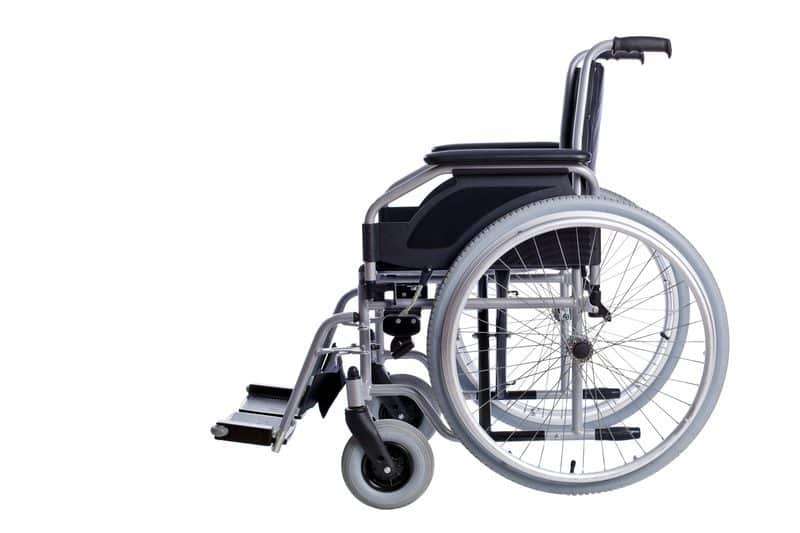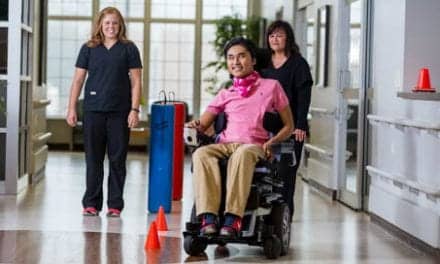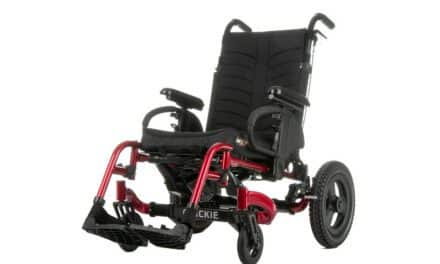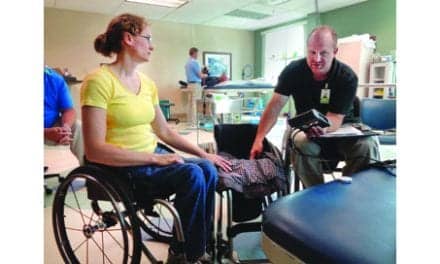The intricacies of manual wheelchair measurement and configuration to improve mobility.
By Kirsten Davin OTD, OTR/L, ATP, SMS
It’s difficult to overstate the importance of accurately configuring a wheelchair to meet the needs of a client. A manual wheelchair that is well fit to the user will often result in greater independence, improved performance in activities of daily living, better postural support, and a reduced risk of compromised skin integrity or pressure injuries for the user. In addition, acquiring an accurate series of anatomical and wheelchair measurements may also enhance the user’s ability to engage in wheelchair mobilization through efficient and effective self-propulsion. All of these benefits can greatly impact a wheelchair user’s quality of life.
Anatomical measurements are derived from measuring the anatomy of the client, while wheelchair measurements are acquired by measuring the wheelchair, at times in comparison to the floor or client’s position.
Fundamental Measurements
Most are familiar with a set of standard anatomical measurements, which are generally used to fit a client, with good trunk control, to a traditional manual wheelchair. These measurements may include, but are not limited to:
Seat Width – Used to identify the appropriate width of the seat, a seat width measurement is achieved by measuring the distance between the widest points of the user’s buttocks, hips, or upper legs. The wheelchair seat should be wide enough so as not to create pressure to the lateral aspect of the client’s buttocks or lower extremities. It is often recommended to add 1 inch of space to this measurement to ensure lateral clearance.
Seat Depth – Used to identify the appropriate length (depth) of the seat, the seat depth measurement is measured from the user’s posterior buttock, along the lateral thigh to the back of the knee, known as the popliteal fossa. Typically, a space of approximately 2 inches is preserved to avoid pressure from the front edge of the seat or cushion against the popliteal space, although this may vary depending upon user’s preference and clinical recommendation.
Seat Height – Measured from the wheelchair user’s heel to the popliteal fossa, this measurement, when applied to equipment selection, should allow for the user’s feet to reach the floor with a functional heel strike while seated in the event they will be self-propelling. Clients who will be using footrests may require a higher seat height to allow for adequate footrest clearance, typically 2 inches from the floor.
Armrest Height – Used to identify the appropriate height of the arm rest in comparison to the user’s anatomy, this measurement is achieved by having the user sit upright, with neutral shoulders, and measuring the distance from the top of the wheelchair seat to the bottom of the elbow. Typically, 1 inch is added to provide necessary support to the upper extremity.
K0005 Ultralightweight
While additional measurements may be required based on the type of chair being selected for the client, the manual wheelchair that allows for the greatest degree of adjustment, thus requiring the most intricate and thorough series of measurements, is an ultralightweight manual wheelchair, also known as a K0005 ultralightweight manual wheelchair.
A K0005 ultralightweight manual wheelchair offers the clinician or assistive technology professional (ATP) the opportunity to incorporate unique specifications including seating and frame adjustments and proper axle positioning to create a wheelchair that offers a precise fit to the user, resulting in enhanced performance, maneuverability, and stability.
Precise and accurate measurement of the client within the K0005 wheelchair, combined with proper axle positioning, will enable clinicians to trial appropriately sized equipment, thus offering the most true-to-life product demonstration. It may also reduce the number of patient transfers and improve time management during the evaluation process.
Most importantly, acquiring and implementing proper measurements when preparing for the issuance of a K0005 wheelchair is crucial to achieving funding for the equipment, as well as completing the final wheelchair and seating configuration during time of equipment delivery.
Important Measurements for Self-Propulsion
In addition to the standard measurements previously noted, additional measurements and configurations specific to a K0005 wheelchair may enhance and promote effective self-propulsion. Such measurements include but are not limited to:
Rear Seat-to-Floor Height – Measured at the rear of the wheelchair directly in front of the back frame post, this measurement, in conjunction with the front seat-to-floor-height measurement, comprises the degree of seat slope. The rear seat-to-floor-height measurement is taken from the top of the wheelchair seat to the floor.
The rear seat-to-floor height aids in determining the location of the rear axle’s vertical placement, by ensuring the client has adequate access to the wheelchair’s hand rims in order to achieve optimal self-propulsion. When assessing a wheelchair user’s fit within the chair, ask the user to sit in the chair. The tip of the user’s middle finger should align with the wheel’s axle, indicating correct positioning and resulting in efficient self-propulsion.
Front Seat-to-Floor Height – Measured at the front frame of the wheelchair, where the anterior portion of the seat conjoins with the frame, the front seat-to-floor height is measured from this location to the floor.
A front seat-to-floor height that correlates well with the client’s anatomical measurements will provide adequate support of the femur and lower extremities to produce favorable stability and pressure distribution. It may also aid in reducing the risk of skin breakdown.
When determining both the front and rear seat-to-floor height, and how these measurements play into the entirety of the wheelchair fit, it is imperative to consider the height, or thickness, of any wheelchair cushion that may be in use. Some wheelchair cushions—for example, an anti-thrust or wedge cushion—are designed with greater anterior thickness, and a reduced posterior height. You’ll need to include cushion height, both anterior and posterior, in the overall calculation and fit, for if it is not accurately considered, seat slope may be affected.

Seat Slope
Front and rear seat-to-floor-height measurements may not always be equal in an optimally configured K0005 manual wheelchair. Seat slope, commonly referred to as “seat dump,” is defined as the difference between the front seat-to-floor height and the rear. It is an important adjustment and consideration, as proper seat slope application is an essential component of overall postural stability and drive wheel access for self-propulsion.
The benefits to incorporating appropriate seat slope can include increased postural and pelvic stability for those who present with reduced trunk control. Accurate alignment of the upper extremity to the drive axle is also a benefit, and when coupled with improved postural stability it can result in a significant improvement in self-propulsion, maneuverability, and agility with wheelchair use.
While the benefits are significant, the implementation of too great of a seat slope can potentially cause complications. If adding significant seat slope results in the seat to back angle of the wheelchair promoting a greater degree of hip flexion than the user can perform or tolerate, or if the seat slope narrows the seat to back angle to a point that the user cannot comfortably or effectively fit into the chair, the user may find themselves pulling out of the seating system and/or settling into a position of inappropriate pelvic tilt. Use of a demonstrator wheelchair that is set up comparably to the desired final chair setup will be helpful in visualizing the overall fit.
If a conventional seat slope cannot be implemented, due to various reasons, some of which are listed here, use of an ergonomic (ergo) seat may offer a viable solution. An ergo seat creates the desired shape at the frame, via a bend in wheelchair frame, thus accommodating the frame to the client rather than having to attempt to accommodate via seat slope.
Rear Axle Positioning and Self-Propulsion
When evaluating a client during the fitting of a new manual wheelchair, the anatomical and wheelchair measurements noted here, along with a comprehensive seating assessment, should aid in positioning the user’s upper torso and extremities in a prime location for effective self-propulsion. When you position the rear axle directly underneath the user’s center of mass, the user generally experiences greater ease in self-propulsion, reduced friction forces, and a reduction in the upper extremity repetition required to propel the chair. Ideally, this results in a reduced risk of upper extremity overuse syndrome.
In addition to the vertical position of the rear axle, discussed above, the horizontal placement of the rear axle also has a significant impact on overall stability, weight distribution, and efficiency in propulsion. Just as one would assess the vertical positioning of the client in relationship to the rear axle via fingertip placement as noted above, proper horizontal placement of the rear axle can be confirmed via a similar technique.
When the rear axle is appropriately placed under the center of mass of the client, the majority of the user’s weight—ideally approximately 80% of the user’s body weight—is seated on the rear axle, with the remainder of the client’s weight, up to 20%, being distributed over the front casters, leg rests, and foot plates. If too much weight is distributed across the front casters, among other concerns, greater force will be required to self-propel, thus causing increased stress application to the upper extremities as well as increased risk of repetitive use injury.
If the horizontal positioning of the rear axle is too far forward, not only will this result in less efficiency in self-propulsion, but also increased rolling resistance, a tendency for the wheelchair to tip backward, and challenges with maneuvering the wheelchair, including the performance of wheelies to maneuver obstacles.
Anatomical and wheelchair measurements, along with visual assessment of the user’s fit within the wheelchair, are all contributing factors to the creation of a well-fitting seating system. Achieving this goal will result not only in improved self-propulsion performance for your client, but also a reduction in the risk of overuse injuries. This can make a world of difference to a client’s health and well-being.
Kirsten Davin, OTD, OTR/L, ATP, SMS, an occupational therapist of more than 20 years and expert in the seating/positioning industry, currently serves as a clinical assistant professor and academic fieldwork coordinator for Baylor University’s Occupational Therapy Doctorate Program. For more information, contact [email protected].





